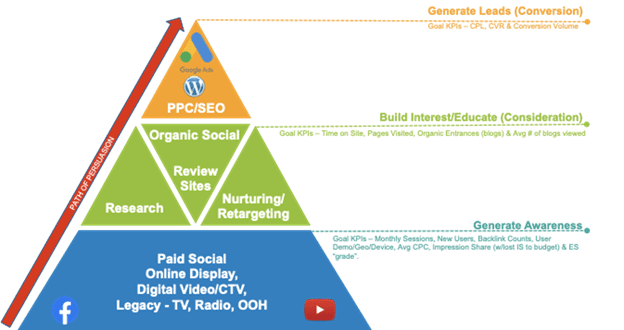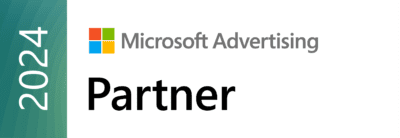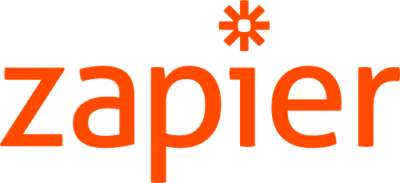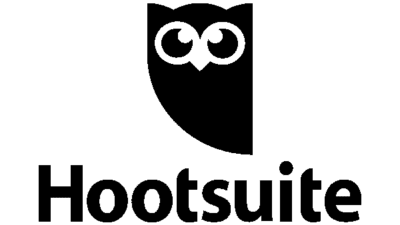Everyone who’s out there engaging in the digital marketing space wants to make the most of their budget and channel mix allocations while also staying on top of the latest trends, tech developments, and algorithm shifts. It’s a conversation we have a lot at EdwardsSchoen, and we’ve found one of the best ways to help out clients maximize their digital efforts is to break down where things currently are, what’s on the horizon, and how to use all that to evaluate a better, more effective strategy.
Where We’re at Right Now

When it comes to looking at channel mix at a high level, most of the schools that we talk to and work with at EdwardsSchoen are understandably focused on the conversion bucket at the very end of the funnel. This is where the vast majority of their budgets go to, and it makes sense because we see the most immediate return on investment through direct response within paid search. Someone actively searches for you or for one of your relevant terms, they go to your webpage, and TA DA! Lead generation.
But if you’re in the position where there is less demand or less awareness of your school, it’s worth looking at the rest of those elements of the digital landscape:
- Affiliates: We’ve done several audits over the past years, and we see a lot of schools that heavily rely on the affiliate channel for anywhere from 50 to 90 percent of their leads. These days, while there are still some volume players out there, affiliates aren’t quite the giant category they used to be. In fact, we’ve done audits where we’ve seen conversions at less than half a percent, even as thousands of dollars are being allocated to these sources.
- Paid Social: This can be hit and miss for a lot of schools, although we still believe it should be a part of your ongoing efforts. Partnering with an agency that can help you evaluate your paid social efforts and pinpoint reasons why it might not be converting can help you maximize this part of your budget allocation.
- Website: This is probably the area that we emphasize the most when we first onboard new clients, and it breaks down into three core things: SEO and general website optimizations; user experience and how you’re evaluating conversion of traffic; and content and having a strategic plan to regularly add new content to your site, whether via blogs or other things of that nature.
- Awareness Strategy: If people aren’t aware of you, they can’t search for you or research you, so make sure you have a plan in place for building brand awareness. Whether that’s a YouTube campaign, investing in OTT, etc.
- Messaging Strategy: Do you understand who your audience is, where they are, and what you have to offer them? You need to be able to break down your Unique Selling Propositions (USPs), and it needs to go beyond the basics like “individual attention” and “financial aid available.” You might even need to survey your student population to help you build out fleshed out, thoughtful USPs.
What’s New
Automated Bidding
In the beginning, the main tactic for Google ads was the buy the most relevant keywords possible and then bid against them in ways that provided the best results. But recently, the Google Ads platform has become more sophisticated, and there are now several automated bidding options for how leads can be purchased:
- Maximize clicks — automatically sets your bids to help get as many clicks as possible within your budget
- Target impression share — automatically sets bids with the goal of showing your ad on the absolute top of the page, on the top of the page, or anywhere on the page of Google search results
- Target CPA — automatically sets bids to help get as many conversions as possible at the target cost-per-action you set (some conversions may cost more or less than your target)
- Target ROAS — automatically sets bids to help get as much conversion value as possible at the target return on ad spend (ROAS) you set (some conversions may cost more or less than your target)
- Maximize conversions — automatically sets bids to help you optimize toward conversions
- Maximize conversion value — automatically sets bids to help you get the most conversion value for your campaign while spending your budget
Some of the pieces that Google is now automating include ad creatives and how they are delivered, removing keywords for redundancies or low performance, and even testing new headlines or other parts of creative that they can just insert automatically and run through the gauntlet to see what might convert best.
Updated Attribution Models
At the start, advertisers typically measured the success of their online advertising on a last-click basis, meaning we would give all credit for a conversion to the last ad clicked or last corresponding keyword, ignoring the other ad interactions along the way. This really downplays the overall customer journey and doesn’t give you a complete view of how the funnel might work.
Enter: Google and their updated attribution models. These provide us with more control over how much credit each ad interaction gets for conversions and lets us see the larger picture of the overall funnel. It would give us the chance to find opportunities to influence prospects earlier on their path to conversion. It can also help us improve our bidding strategies.
These new attribution models include:
- First click —Gives all credit for the conversion to the first-clicked ad and corresponding keyword
- Linear — Distributes the credit for the conversion equally across all ad interactions on the path.
- Time decay — Gives more credit to ad interactions that happened closer in time to the conversion. Credit is distributed using a 7-day half-life. In other words, an ad interaction 8 days before a conversion gets half as much credit as an ad interaction 1 day before a conversion.
- Position-based — Gives 40% of credit to both the first and last ad interactions and corresponding keywords, with the remaining 20% spread out across the other ad interactions on the path.
- Data-driven (default as of 6/2022) — Distributes credit for the conversion based on your past data for this conversion action. It’s different from the other models, in that it uses your account’s data to calculate the actual contribution of each interaction across the conversion path.
Google Performance Max
Google Performance Max is relatively new on the scene, having launched in late 2021, and it’s the latest product offering in the company’s march toward automation. Performance Max is a goal-based campaign type that allows advertisers to access all of the Google Ads inventory from a single campaign. They are designed to complement keyword-based search campaigns to help find more converting customers across all of Google’s channels.
Results from these campaigns so far have been mixed, but we see it as a huge area of opportunity. They’re seen as more of a hands-off approach once your settings are in place because of their overall level of automation, so you’ll need to pay close attention to them and specifically how each of your assets is performing. You can add photos, videos, specific search terms, and even very specific audience signals, and it adds value by optimizing performance in real time across all channels. Essentially, Google knows who your audience likely is based on various signals, and they’re saying, “Hey, we know when your audience is online and what they’re doing, so let’s reach out to them,” regardless of whether or not they’re currently searching for a school. It’s a great way for more awareness at the top of the funnel, and to date, we’ve seen significantly lower CPLs from Performance Max campaigns.
What’s Next
Google Analytics 4
In July 2023, Google will be getting rid of what has been their analytics profile for pretty much forever in favor their new analytics: GA4. If you haven’t built profiles for these in your overall Analytics accounts, you should definitely look into doing that. Google keeps updating and changing some of the things they’re offering over time, so as long as you’re ready to go by July, you should be good.
Store Visit Conversions
This is one of the newer things that our Google reps have been pushing recently. They want us to allow Google to see users that interact with our ads and also visit the location or the school. Essentially, Google wants to be able to compare data sets of people who’ve walked through your doors (via cell phone location) to those they’ve been showing your ads to recently or who clicked on your ads recently so they can update and refine their audience segments. Which feeds into…
Updated Audience Targeting and Keyword Strategy
There is a planned update to audience targeting coming in May 2023. Google will no longer have audience segments similar to those you might see with Facebook because of privacy concerns. Instead, they will be upgrading to more powerful automated solutions like optimized targeting audience expansion and smart bidding.
Google is now also pushing for the use of more broad-match keywords in every format rather than just phrase-match. Google has become more an intent engine, and they claim to be able to see what users are really looking for in the context of their recent search history, etc. Broad-match keywords help give them a larger community to do what they do in terms of finding the conversions everyone is looking for.
How to Evaluate Your Marketing Efforts
When we sit down to talk to a client about their digital marketing strategy, we always start with identifying their institutional goals. Looking at things like cost per start, cost per enrollment, cost per inquiry, how many inquiries do we need — these are all definitely important things to measure, they don’t tell the full story insofar as how optimized your marketing campaign is.
Within your digital strategy and execution, you should be constantly evaluating to ensure you’re performing at the best level. So if CPIs are lower or enrollments are up, some things might get neglected before overall performance looks good, but you have to consider how much better could it be, how much more you could yield. This means having a deeper understanding of each channel’s specific opportunities and conducting formal reviews to help ensure you’re effectively driving performance.
Here are a few of the common pitfalls we come across, whether we’re doing a first-time audit or a peer review or just an overall performance check of our campaigns:
Paid Search/Video/Display
- Make sure you develop a 1:1:1 strategy, including the ad quality and RSAs. Meaning, not only are you picking the most relevant keywords, but those keywords are also in your ad content and your landing pages. If Google sees that, it will increase your overall ad quality and responsive search ad strategy.
- Analyze your conversion value strategy and ensure that your form completion conversions are worth more than, for example, your phone call conversions
- Utilize automated bidding and audience targeting and making sure that you’re selecting the type for each of those different things with consideration for your budget
Paid Social
- Let Meta/Facebook do its thing. The more you can allow it to be automated, the more you’re hands off, the better we’ve seen those results come through
- Keep an eye on impression frequency. Don’t allow ad frequency per user to go over 2-3 because the platform will start to suppress you ads, so once you hit that limit, it’s time to get some fresh creative into the mix
- Update your audiences so that you’re not advertising to people who have already become leads, as well as growing customer lists to help better target for lookalike audiences
SEO
- Watch out for thin or non-comprehensive content because Google still wants to see robust posts, pages, and blogs to bring traffic to your site
- Take advantage of all the different pieces that go into your Google Business profiles so that if they’re looking at your map location or Google Business, they’re seeing as much as possible and you’re controlling that content
- Keep up with internal redirects as your sites age as this can have a big impact on overall site quality and how Google is ranking you
The EdwardsSchoen Advantage

ES has developed a comprehensive scorecard that covers all assets of digital marketing, from PPC to Paid Social to SEO, and the tools we use to assess and analyze them. Whether you’re a new, current, or prospective client, when we do an audit, this is an example of what you’ll receive as a result. The idea is to ensure we’re evaluating all of the various facets of each of these campaigns regularly. We want you to have a firm handle on how we’re meeting expectations for all of these individual elements of our strategy.
If you’re looking for a true partner in education who can do a deep-dive assessment of your marketing mix and help you identify new opportunities, we’re ready to have a conversation. Contact EdwardsSchoen or give us a call today.
Recent Posts
- Diversifying Enrollment: Strategies for Attracting a Wide Range of Students to Private Postsecondary Institutions September 14, 2023
- XR and the Transformation of Online Education August 24, 2023
- Key Takeaways From the 2023 State of Social Media Report July 25, 2023
- SEO: Why It Stays Important and How to Get Key Decision Makers Onboard June 22, 2023
- Revolutionizing Content Generation: Harnessing AI June 9, 2023










